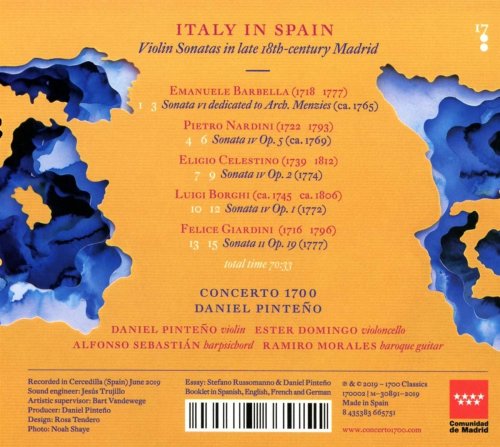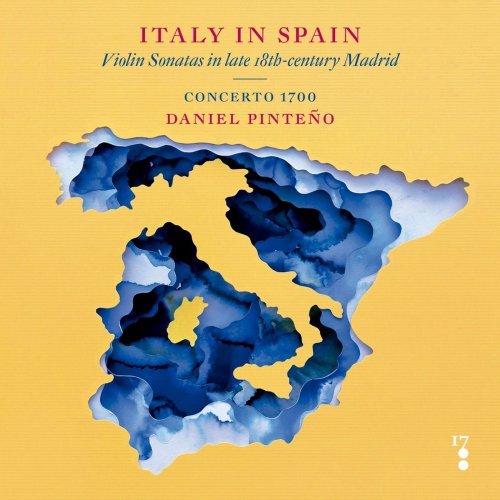
Concerto 1700 & Daniel Pinteño - Italy in Spain: Violin Sonatas in late 18th-Century Madrid (2019)
BAND/ARTIST: Concerto 1700, Daniel Pinteño
- Title: Italy in Spain: Violin Sonatas in late 18th-Century Madrid
- Year Of Release: 2019
- Label: 1700 Classics
- Genre: Classical
- Quality: flac lossless
- Total Time: 01:10:33
- Total Size: 404 mb
- WebSite: Album Preview
Tracklist
01. Violin Sonata No. 6 in G Major: I. Larghetto e con gusto
02. Violin Sonata No. 6 in G Major: II. Allegretto
03. Violin Sonata No. 6 in G Major: III. Allegretto brillante. Alla francese
04. Violin Sonata No. 4 in D Major, Op. 5: I. —
05. Violin Sonata No. 4 in D Major, Op. 5: II. Allegro
06. Violin Sonata No. 4 in D Major, Op. 5: III. Allegro
07. Violin Sonata No. 4 in F Major, Op. 2: I. Largo
08. Violin Sonata No. 4 in F Major, Op. 2: II. Allegro
09. Violin Sonata No. 4 in F Major, Op. 2: III. Minuetto. Andantino
10. Violin Sonata No. 4 in D Major, Op. 1: I. Allegro
11. Violin Sonata No. 4 in D Major, Op. 1: II. Largo
12. Violin Sonata No. 4 in D Major, Op. 1: III. Rondeau. Andante amoroso
13. Violin Sonata No. 2 in B-Flat Major, Op. 19: I. Adagio
14. Violin Sonata No. 2 in B-Flat Major, Op. 19: II. Presto assai
15. Violin Sonata No. 2 in B-Flat Major, Op. 19: III. Grazioso

Nowadays, the Spanish National Library holds dozens of violin sonata collections by Italian composers published in London, Amsterdam or Berlin in the 1760s and 1770s. Their authors' names might be unknown to a music lover nowadays but were well known by the public in their time. So much so that it is easy to find references to Italian violinists like Tartini, Borghi, Nardini, Ferrari or Barbella in concert chronicles and advertisements published by then-recent Madrid press in the second half of the 18th-century. The question that arises is: how did these sonatas get here? The crucial clue to understanding how all these Italian collections came to Madrid is given by the seal of the Library of the Royal Palace of Madrid, which can be seen in the covers of all them. One can thus infer that these were collections that English, French, Dutch and German publishers periodically sent motu proprio to the Spanish court as a sample of the musical novelties that were being printed in other countries. Although one might also ask: were they ever played in court? It is a difficult question to answer, but in any case, these scores represented an open window to what was happening in the European music scene, a compilation of the tendencies and the great changes in style that were taking place at that time. For a short while, the last echoes of the Baroque, the Galant style and the first appearances of Classicism coexisted. This program gathers a small but representative sample of this important material composed between 1760 and 1777. An exciting journey through an imaginary border that gathers two thrilling times that are yet to be studied in depth is thus started.
01. Violin Sonata No. 6 in G Major: I. Larghetto e con gusto
02. Violin Sonata No. 6 in G Major: II. Allegretto
03. Violin Sonata No. 6 in G Major: III. Allegretto brillante. Alla francese
04. Violin Sonata No. 4 in D Major, Op. 5: I. —
05. Violin Sonata No. 4 in D Major, Op. 5: II. Allegro
06. Violin Sonata No. 4 in D Major, Op. 5: III. Allegro
07. Violin Sonata No. 4 in F Major, Op. 2: I. Largo
08. Violin Sonata No. 4 in F Major, Op. 2: II. Allegro
09. Violin Sonata No. 4 in F Major, Op. 2: III. Minuetto. Andantino
10. Violin Sonata No. 4 in D Major, Op. 1: I. Allegro
11. Violin Sonata No. 4 in D Major, Op. 1: II. Largo
12. Violin Sonata No. 4 in D Major, Op. 1: III. Rondeau. Andante amoroso
13. Violin Sonata No. 2 in B-Flat Major, Op. 19: I. Adagio
14. Violin Sonata No. 2 in B-Flat Major, Op. 19: II. Presto assai
15. Violin Sonata No. 2 in B-Flat Major, Op. 19: III. Grazioso

Nowadays, the Spanish National Library holds dozens of violin sonata collections by Italian composers published in London, Amsterdam or Berlin in the 1760s and 1770s. Their authors' names might be unknown to a music lover nowadays but were well known by the public in their time. So much so that it is easy to find references to Italian violinists like Tartini, Borghi, Nardini, Ferrari or Barbella in concert chronicles and advertisements published by then-recent Madrid press in the second half of the 18th-century. The question that arises is: how did these sonatas get here? The crucial clue to understanding how all these Italian collections came to Madrid is given by the seal of the Library of the Royal Palace of Madrid, which can be seen in the covers of all them. One can thus infer that these were collections that English, French, Dutch and German publishers periodically sent motu proprio to the Spanish court as a sample of the musical novelties that were being printed in other countries. Although one might also ask: were they ever played in court? It is a difficult question to answer, but in any case, these scores represented an open window to what was happening in the European music scene, a compilation of the tendencies and the great changes in style that were taking place at that time. For a short while, the last echoes of the Baroque, the Galant style and the first appearances of Classicism coexisted. This program gathers a small but representative sample of this important material composed between 1760 and 1777. An exciting journey through an imaginary border that gathers two thrilling times that are yet to be studied in depth is thus started.
Year 2019 | Classical | FLAC / APE
As a ISRA.CLOUD's PREMIUM member you will have the following benefits:
- Unlimited high speed downloads
- Download directly without waiting time
- Unlimited parallel downloads
- Support for download accelerators
- No advertising
- Resume broken downloads


